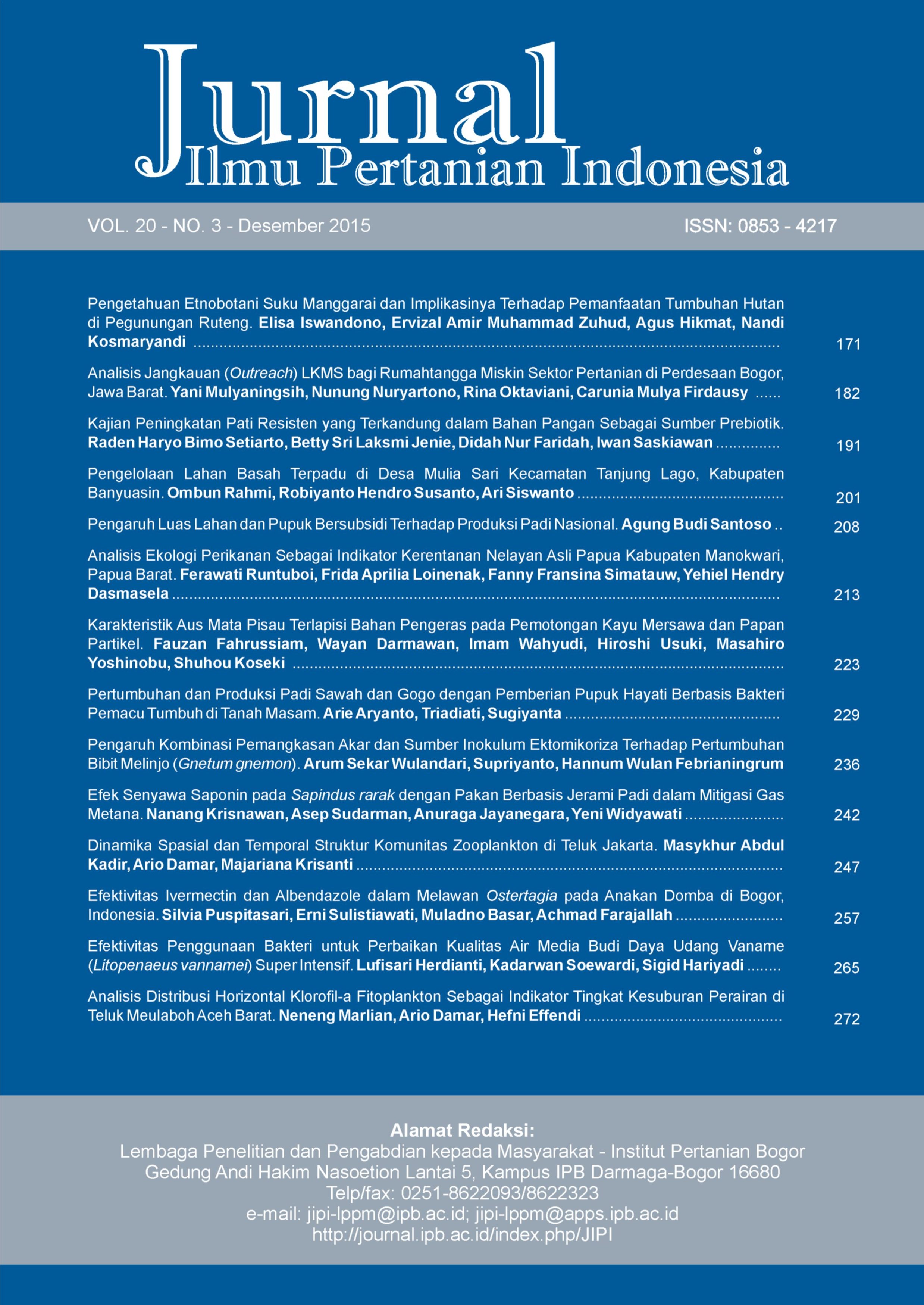Karakteristik Aus Mata Pisau Terlapisi Bahan Pengeras pada Pemotongan Kayu Mersawa dan Papan Partikel
Abstract
The use of mersawa wood and particleboard as a materials has been increasing for building constructions and decorative purpose. In previous study reported that, these materials provide a high rate of wear caused by abrasion (high silica) and resin content. This article presents the characteristics of wear on the clearance face of newly multilayer-coated K10 cutting tools when milling mersawa wood and particleboard. The K10 cutting tools were coated with monolayer titanium aluminum nitride (TiAlN), multilayer TiAlN/titanium silicon nitride (TiSiN), and TiAlN/titanium boron nitride (TiBN). Mersawa wood with density of 0.80 g/cm3 and particleboard with a density of 0.61 g/cm3 were cut using the coated tools and uncoated K10. Cutting tests were performed on computer numeric control router at a high cutting speed of 17 m/s and a feed rate of 0.1 mm/rev to investigate the wear characteristics on the clearance face of these coated tools. Result of research shown that the coated tools experienced a smaller amount of wear than the uncoated tool when cutting the mersawa and particleboard. The best coating among other coated in this study was multilayer TiAlN/TiBN. The high hardness, low coefficient of friction, high resistance to oxidation, and high resistance to delamination wear of the multilayer-coated TiAlN/TiBN tool indicate a very promising applicability of this coating for high-speed cutting of abrasive woods and wood based materials.Downloads
References
ASTM International. 2006. Standard guide for corrosion tests in high temperature or high pressure environment. ASTM G111-97. In: Annual Book of ASTM Standards. 03(02). Philadelphia (US): ASTM International. http://doi.org/cvfz2g
ASTM International. 2009. Standard practice for instrumented indentation testing. ASTM E2546-07. In: Annual Book of ASTM Standards. 03(01). Philadelphia (US): ASTM International. http://doi.org/fxhj6v
ASTM International. 2010. Standard test method for wear testing with a pin-on-disk apparatus. ASTM G99-05. In: Annual Book of ASTM Standards. 03(02). Philadelphia (US): ASTM International. http://doi.org/bdjsqh
Chang CL, Chen WC, Tsai PC, Ho WY, Wang DY. 2007. Characteristics and performance of TiSiN/TiAlN multilayer coatings synthesized by cathodic arc plasma evaporation. Surface and Coatings Technology. 202(4-7): 987-992. http://doi.org/bbf7ng
Darmawan W, Tanaka C, Usuki H, Ohtani T. 2001. Performance of coated carbide tools when grooving wood-based materials: Effect of work materials and coating materials on the wear resistance of coated carbide tools. Journal of Wood Science. 47(2): 94-101. http://doi.org/fnbz98
Darmawan W, Rahayu IS, Tanaka C. 2006. Chemical and mechanical wearing of woodworking cutting tools by tropical woods. Journal of Tropical Forest Science. 18(4): 166-172.
Darmawan W, Rahayu I, Nandika D, Marchal R. 2012. The Importance of Extractives and Abrasives in Wood Materials on the Wearing of Wood Cutting Tools. Journal of BioResources. 7(4): 4715-4729. http://doi.org/72w
Ding XZ, Tan ALK, Zeng XT, Wang C, Yue T, Sun CQ. 2008. Corrosion resistance of CrAlN and TiAlN coatings deposited by lateral rotating cathode arc. Thin Solid Films. 516(16): 5716-5720. http://doi.org/cb8w74
Fuch I, Raatz C. 1997. Study of wear behavior of specially coated (CVD, PACVD) cemented carbide tools while milling of wood-based materials. In: Proceedings of the 13th International Wood Machining Seminar. University of British Columbia, Vancouver, B.C. (CA), June 17-19, pp 709-715.
Salje E, Stuehmeier W .1988. Milling particleboard with high hard cutting materials. In: Proceedings of the Ninth International Wood Machining Seminar. University of California Forest Products Laboratory, Richmond, California (US), October 10-12, pp 211-228.
Sheikh-Ahmad JY, Stewart JS. 1995. Performance of different PVD coated tungsten carbide tools in the continuous machining of particleboard. In: Proceedings of the 12th International Wood Machining Seminar. Kyoto University, Kyoto (JP), October 2-4, pp 282-291.
Sheikh-Ahmad JY, Bailey JA.1999. High-temperature wear of cemented tungsten carbide tools while machining particleboard and fiberboard. Journal of Wood Science. 45(6): 445-455. http://doi.org/cfjk23
Sheikh-Ahmad JY, McKenzie WM. 2000. Measurement of tool wear and dulling in the machining of particleboard. In: Procedings of the 13th International Wood Machining Seminar. Vancouver (CA), Juni 17-20, pp 659-670.
Stewart HA. 1992. High-temperature halogenation of tungsten carbide cobalt tool material when machining medium density fiberboard. The Forest Products Journal. 42(10): 27-31.
TAPPI. 1991. TAPPI Test Methods: Ash in Wood and Pulp (T211 om-85), Vol. 1. Atlanta (US): TAPPI Press.
Usuki H, Uehara K, Isaka M, Kubota K. 2013. Machining of Inconel 718 with Lubricant-Coated Tool. International Journal of Automation Technology. 7(3): 306-312.
This journal is published under the terms of the Creative Commons Attribution-NonCommercial 4.0 International License. Authors who publish with this journal agree to the following terms: Authors retain copyright and grant the journal right of first publication with the work simultaneously licensed under a Creative Commons Attribution-NonCommercial 4.0 International License. Attribution — You must give appropriate credit, provide a link to the license, and indicate if changes were made. You may do so in any reasonable manner, but not in any way that suggests the licensor endorses you or your use. NonCommercial — You may not use the material for commercial purposes.






















